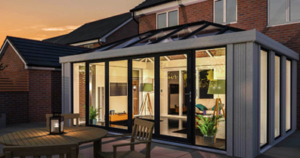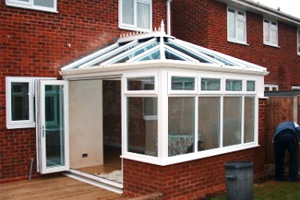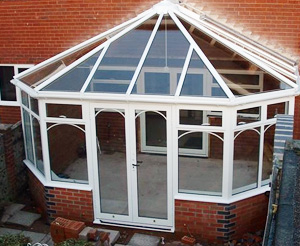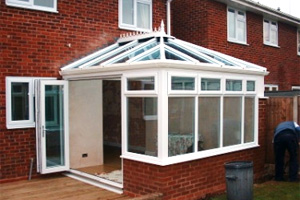Aluminium vs. UPVC Conservatories: Which Is Right for You?
Aluminium vs. UPVC Conservatories: Which Is Right for You?
Choosing the right material for your new conservatory, uPVC or Aluminium, depends on several choices. UPVC has been the most common choice for around thirty years, being much more durable and easier to maintain than wood. However, new technologies are allowing more and more properties access to quality coated aluminium frames that are just as attractive and even more durable. This guide compares Aluminium vs UPVC conservatories to help you understand the pros and cons.
Aesthetic Appeal
Typically, an older uPVC conservatory is made from white profiles that can yellow or , but today’s uPVC can be coloured easily and even textured. Choose from a range of subtle colours, such as cream, anthracite grey or sage green, that are very popular for rural settings. These colours soften the look of a conservatory and can match other fittings around the property.
Some choose a wood effect uPVC finish, which is applied to the surface of the profiles. This is available in rosewood, light oak or Irish oak effects, providing a traditional look without the maintenance.
Coloured UPVC Conservatory Brochure
Aluminium frames are available in almost any colour, as they are coated during fabrication. Another aesthetic advantage of an aluminium conservatory is that the profiles are much stronger and lighter. They can therefore support larger panes of glass than uPVC can, with much slimmer frames. This gives you more natural light and better sightlines into the garden than is possible with uPVC.
Aluminium Conservatory Colours

Durability & Maintenance
There’s no doubt that aluminium is more durable than uPVC. It is completely weatherproof, does not degrade under UV light, and has much greater density and strength. While uPVC structures can last up to 30 years, they may become brittle and yellow over time. Aluminium frames will keep their appearance and strength for up to half a century.
Both aluminium and uPVC are easy to maintain, with just a damp cloth doing most of the work of cleaning your conservatory. As the colours don’t fade over time, there’s no need to repaint or varnish as there would be with a wooden frame.
Thermal Insulation
Both uPVC and aluminium conservatories have excellent thermal insulation, preventing them from becoming cold in winter and too hot in summer. UPVC profiles achieve this with low conductivity in the material and multiple breaks in the shape, reducing the number of cold bridges available.
Aluminium is ordinarily highly conductive, allowing heat to travel through it quickly. Conservatories constructed from aluminium are made using specialised profiles that contain a thermal break, a layer of non-conductive material at their cores.
Combined with double or triple-glazing, both uPVC and Aluminium conservatories provide excellent thermal insulation. These properties also contribute to noise insulation as well, allowing you to enjoy your sunroom in peace and quiet.
Strength and Flexibility
The difference in strength between UPVC and Aluminium determines what structures can be created with each.
uPVC is easily moulded into the profiles, but is reasonably strong, ideal for single-storey structures with simple designs. This is a quick and affordable option.
Aluminium frames are strong enough to create taller sunrooms or orangeries, complex roof structures. Being a lightweight metal, aluminium can be used to construct a conservatory in almost any shape and height. Custom aluminium conservatories can make the most of every space.
Conservatory Cost
Are aluminium conservatories more expensive than UPVC?
In the UK, uPVC is widely used for both conservatories and windows, so it is affordable to produce at scale. While the cost of a conservatory will depend on the design, size, and finish, for a conservatory of identical size, uPVC is the cheaper option for consumers.
Aluminium frames are not as widely produced at present, but are gaining in popularity, and may become more affordable in time. Many consider an aluminium conservatory a long-term investment, as it will not need replacing as soon as a uPVC one. If you can manage the higher initial cost, aluminium is so durable that it is worth the expense.
Benefits of UPVC
✔ Durable and long-lasting, up to 30 years.
✔ Available in a range of colours and finishes
✔ Low Maintenance
✔ Thermally Insulated
✔ More Affordable than aluminium
✔ Excellent sound insulation
✔ Ventilation options
View UPVC Conservatory Designs

Benefits of Aluminium
✔ Durable and long-lasting, up to 50 years.
✔ High Strength allows for unique conservatory designs.
✔ Low maintenance
✔ Thermally insulated
✔ Slim frames give more space to glazing
✔ Large panels available
✔ A wide range of durable colour options
✔ Ventilation options
View Aluminium Conservatory Brochure

Aluminium vs UPVC Conservatories
After reading this guide, you should have a good idea of the option that is most suitable for your budget, property and the look you’re hoping to achieve. Aluminium offers more choice and lasts longer, and is well insulated. UPVC is still a strong, easily maintained material for conservatories, and more affordable in the short term.


